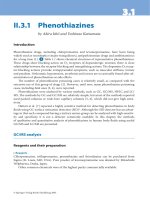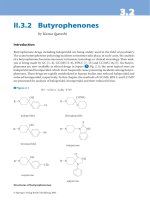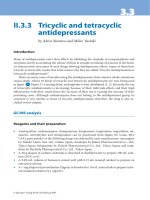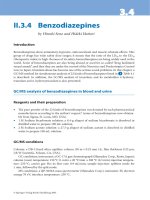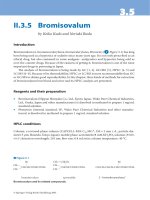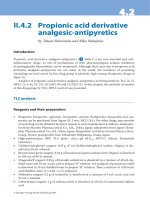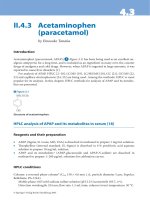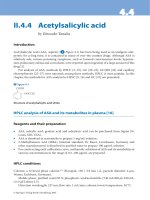Tài liệu Drugs and Poisons in Humans - A Handbook of Practical Analysis (Part 34) doc
Bạn đang xem bản rút gọn của tài liệu. Xem và tải ngay bản đầy đủ của tài liệu tại đây (212.75 KB, 10 trang )
4.2
© Springer-Verlag Berlin Heidelberg 2005
II.4.2 Propionic acid derivative
analgesic-antipyretics
by Tatsuo Shinozuka and Rika Nakajima
Introduction
Propionic acid derivative analgesic-antipyretics (> Table 2.1) are non-steroidal and anti-
in ammatory drugs. As one of mechanisms of their pharmacological actions, inhibition
of prostaglandin biosynthesis can be mentioned. Although fatal cases due to propionic acid
derivative analgesic-antipyretics are not many in the world, the incidence of poisoning
(including survived cases) by this drug group is relatively high among therapeutic drugs in
Japan [1].
Analyses of propionic acid derivative analgesic-antipyretics are being made by TLC [2, 3],
HPLC [2, 4–8], GC [9], GC/MS [10] and LC/MS [11]. In this chapter, the methods of analysis
of this drug group by TLC, HPLC and GC are presented.
TLC analysis
Reagents and their preparation
• Ibuprofen, ketoprofen, naproxen, fenoprofen calcium, urbiprofen, loxoprofen and oxa-
prozin can be purchased from Sigma (St. Louis, MO, USA). For other drugs, pure powder
of each drug can be obtained by direct request to each manufacturer as follows: alminopro-
fen from Maruho Pharmaceutical Co., Ltd., Tokyo, Japan; zaltoprofen from Japan Chemi-
phar Pharmaceutical Co., Ltd., Tokyo, Japan; thiaprofenic acid from Aventis Pharma, Stras-
bourg, France; pranoprofen from Mitsubishi Welpharma, Osaka, Japan.
• High-performance (HP) TLC plate
a
: silica gel 60 F
254
HPTLC (Merck, Darmstadt,
Germany).
• Dichloroindophenol reagent: 0.05 g of 2,6-dichloroindophenol sodium (Sigma) is dis-
solved in 50 mL ethanol.
• Bromocresol green reagent: 0.04 g of bromocresol green sultone form (Sigma) is dissolved
in 100 mL of 96 % ethanol.
• Dragendor reagent: 0.85 g of bismuth subnitrate is dissolved in a mixture of 40 mL dis-
tilled water and 10 mL acetic acid to prepare “A” solution. A 8-g aliquot of potassium iodide
is dissolved in 20 mL distilled water to prepare “B” solution. en, a mixture of A/B/acetic
acid/distilled water (1:1:4:20, v/v) is prepared.
• Ninhydrin reagent: 0.2 g of ninhydrin is dissolved in a mixture of 5 mL acetic acid and
95 mL n-butanol.
• Liebermann’s reagent: 2 g of sodium nitrite is dissolved in 20 mL of concentrated sulfuric
acid.
326 Propionic acid derivative analgesic-antipyretics
⊡ Table 2.1
Structures of propionic acid derivative analgesic-antipyretics
alminoprofen
ibuprofen
oxaprozin
ketoprofen
zaltoprofen
tiaprofenic acid
naproxen
fenoprofen calcium
pranoprofen
flurbiprofen
loxoprofen sodium
327
Developing solvents
Benzene/acetone (3:2, v/v).
n-Butyl ether/n-hexane/acetic acid (20:4:1, v/v).
Chloroform/methanol/acetic acid (45:5:1, v/v).
Procedure
i. A 0.1-mL volume of urine or serum (plasma) is mixed with 0.9 mL of 0.2 M disodium
hydrogenphosphate/0.1 M citric acid bu er solution (pH 3.0), and extracted with 1 mL
chloroform three times.
ii. e combined chloroform extract is mixed well with 0.5 g of anhydrous sodium sulfate to
dehydrate it and passed through lter paper; the ltrate is evaporated to dryness under
reduced pressure.
iii. e residue is dissolved in a small amount of methanol to serve as a test solution.
iv. At a location 1-cm up from the bottom of a TLC plate, the above organic extract is spotted
with a size of 1–2 mm diameter. A er drying the spot, the plate is placed in a development
tank lled with vapor of a developing solvent and the spot is developed with the developing
solvent.
v. A er development, the plate is dried with a blower, and the uorescence is observed under
ultraviolet light at 365 nm; light absorbing spots are also observed under the light at 254 nm.
A er the above observations, the plate is sprayed with each reagent. e tentative identi -
cation is made by spotting the authentic standard together with the test extract. A er
spraying the dichloroindophenol reagent, the TLC plate should be heated at 100 °C to de-
tect spots.
Assessment of the method
> Table 2.2 shows R
f
values of eleven propionic acid derivative analgesic-antipyretics for
HPTLC (normal phase) with three solvent systems.
> Table 2.3 shows the detection limits and
colors of the spots observed under ultraviolet light and a er spraying ve kinds of reagents.
e screening by TLC is simple and rapid for unchanged drugs. Reversed phase TLC for
drug analysis was also reported [2, 3]. e optimization of a solvent system for drug analysis by
TLC can give a useful hint for preparing a mobile phase of HPLC or LC/MS.
HPLC analysis
Reagents
• e sources of drugs are the same as speci ed in the section of TLC analysis. N-Chloromethyl-
phthalimide (N-CMPI) can be purchased from Sigma.
• Oasis
®
MAX cartridges
b
were obtained from Waters (Milford, MA, USA).
HPLC analysis
328 Propionic acid derivative analgesic-antipyretics
⊡ Table 2.2
R
f
values of propionic acid derivative analgesic-antipyretics obtained by high-performance (HP) TLC
Compound Developing solvents
123
alminoprofen 0.58 0.30 0.64
ibuprofen 0.67 0.53 0.67
oxaprozin 0.66 0.23 0.61
ketoprofen 0.42 0.32 0.64
zaltoprofen 0.66 0.34 0.63
tiaprofenic acid 0.65 0.29 0.61
naproxen 0.57 0.40 0.66
fenoprofen calcium 0.57 0.47 0.67
pranoprofen 0.36 0.03 0.59
flurbiprofen 0.51 0.46 0.65
loxoprofen sodium 0.52 0.23 0.64
1. benzene/acetone (3:2, v/v).
2. n-butyl ether/n-hexane/acetic acid (20:4:1, v/v).
3. chloroform/methanol/acetic acid (45:5:1, v/v).
⊡ Table 2.3
Colors and detection limits of spots of propionic acid derivative analgesic-antipyretics observed
by HPTLC
Componnd Detection limits (µg) (color)
3 4 5 6 7 Ultraviolet light
alminoprofen 1 (light orange) 1 (yellowish
green)
– – 1 (dark
brown)
0.1
ibuprofen 5 (pink) – – – – 2
oxaprozin 1 (light orange) 1 (yellow) 1 (orange) – 1 (brown) 0.1
ketoprofen 1 (pink) – – – 1 (dark gray) 0.1
zaltoprofen 1 (light orange) 1 (yellow) 1 (orange) – 1 (dark
brown)
0.1 (fluorescent)
tiaprofenic
acid
1 (light orange) 1 (yellow) 1 (orange) – 1 (brown) 0.1
naproxen 1 (pink) 1 (yellow) 1 (orange) – 0.5 (yellowish
brown)
0.1 (fluorescent)
fenoprofen
calcium
1 (pink) 2 (yellowish
green)
– – 1 (brown) 1
pranoprofen 1 (pink) 1 (yellowish
green)
1 (orange) – – 0.1 (fluorescent)
flurbiprofen 1 (pink) – – – 1 (yellowish
brown)
0.1
loxoprofen
sodium
5 (pink) – – – 1 (dark gray) 5
3. dichloroindophenol reagent.
4. bromocresol green reagent.
5. Dragendorff reagent.
6. ninhydrin reagent.
7. Liebermann’s reagent.
329
Analytical conditions
Instrument: a Hitachi HPLC (L-6200) instrument equipped with a UV detector (L-2400)
(Hitachi Ltd., Tokyo, Japan); column: LiChrospher RP-18 (e) (250 × 4.0 mm i.d., Merck, Darm-
stadt, Germany); mobile phase: methanol/puri ed water (70:30, v/v); its ow rate: 0.5 mL/min;
detection wavelength: 293 nm.
Procedures
• Preparation-1: the extracts obtained by the procedure i–iii of the TLC analysis section of
this chapter are condensed or diluted before instrumental analysis.
• Preparation-2: solid-phase extraction with an Oasis
®
MAX cartridge is made as follows:
i. A 0.5-mL volume of urine or serum (plasma) is mixed well with 0.1 mL phosphoric acid
and 0.5 mL of puri ed water and poured into an Oasis
®
MAX cartridge, which had been
activated by passing 3 mL methanol and 3 mL puri ed water.
ii. All manipulations are made using a Vac-Elut
®
system (Varian, Harbor City, CA, USA) with
aspiration pressure at 15–20 mmHg.
iii. e cartridge is washed with 2 mL of 50 mM sodium acetate solution containing 5 % meth-
anol, and drugs are eluted with 3 mL of 100 mM phosphoric acid solution/acetonitrile
(20:80, v/v).
iv. e eluate is evaporated to dryness, and the residue is dissolved in 100 µL methanol con-
taining n-caprylic acid as IS.
v. A 50-µL volume of the above solution, 50 µL of 100 mM N-CMPI acetonitrile solution,
50 µL of 100 mM triethylamine acetonitrile solution are placed in a screw cap test tube
(10 × 1.5 cm) and mixed well.
vi. e mixture tube is heated at 80 °C for 30 min in a water bath or on an aluminum block
heater. A er cooling to room temperature, a 1–3 µL aliquot of it is injected into HPLC.
vii. Various concentrations
c
of a target drug are spiked into blank specimens, and processed
according to the above procedure to construct a calibration curve; the IS is also added at
the step iv. e peak area ratio of a test compound to IS is applied to the calibration curve
to obtain its concentration.
Assessment of the method
> Figure 2.1 shows an HPLC chromatogram for methylphthalimide (MPI) derivatives of eight
propionic acid derivative analgesic-antipyretics
d
. e retention times and detection limits of
the drugs obtained by this method are shown in
> Table 2.4.
HPLC analysis
